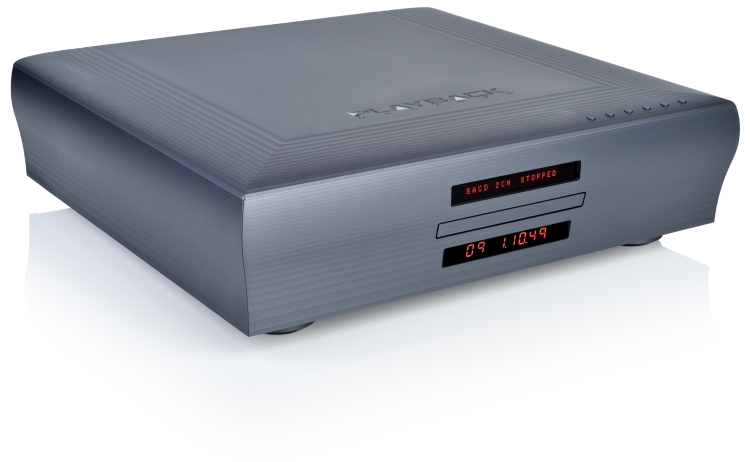Weiss DAC502 DSP DAC and Network Renderer
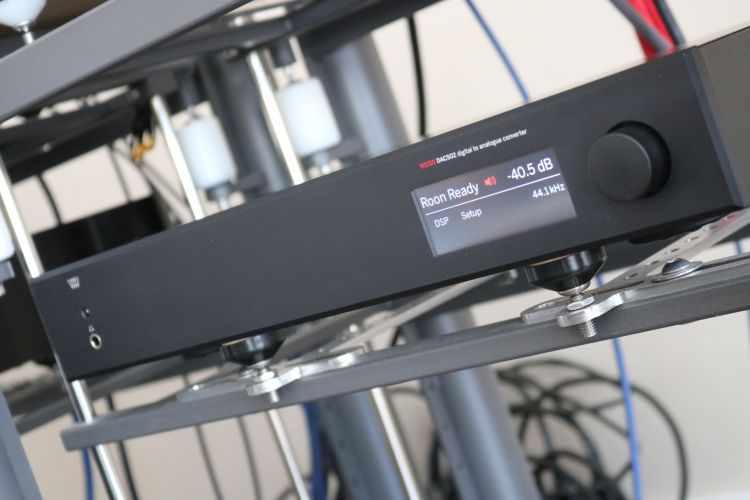
Review sample supplied by Weiss
Retail prices in the Benelux (including 21% VAT)
DAC501: 8.900 euro
DAC502: 10.000 euro
Swiss precision. The reputation is as old as time itself. But more and more Swiss audio products are positioned as front runners at audio shows worldwide. Weiss has been around for a long time alongside other established Swiss brands such as Nagra, FM-Acoustics and darTZeel to name only a handful. But all these brands, along with the relative newcomers such as Soulution and CH Precision seem to prove my point. Whereas the USA used to dominate the ultra-high-end market for so many years, Switzerland, it seems, is the new King.


Originating from the professional recording industry, Daniels Weiss’ audiophile DACs have always received high praise. And the best part is that these products are positioned at the “still attainable” end of the spectrum rather than the “arm and leg” category.
Sadly, my personal experience with the brand so far has been limited to a single DAC and in a time when I was still very much in what I will refer to as my “American” period. Back then, I was chasing the smoothest and richest, most fluid sound and I would prefer a DAC that sounds rounded yet sweet and forgiving over one that is more accurate and transparent. It was in this period that a friend brought over the Weiss DAC2 and I briefly listened to it. Even though the press was raving about it I found it to sound a little too technical for my taste at that time.
These days, though, I don’t want any more sweeteners added to my music. No thanks, I am all about precision, neutrality, transparency and pure naturalness. You certainly won’t hear me claim that the audio products from the Swiss all sound the same but I can’t help but notice that the country’s famous precision as well as its political neutrality both seem to be reflected in a large chunk of the audio products. Weiss is one such product. Renowned for their neutrality and seen as an important reference by many.
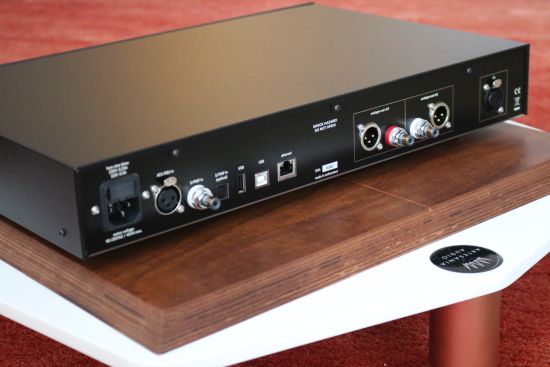
Technical
I won’t go into the technical details too much because this can easily be found on the manufacturer’s website. What I will mention, though, are the headlines and anything else that I deem interesting.
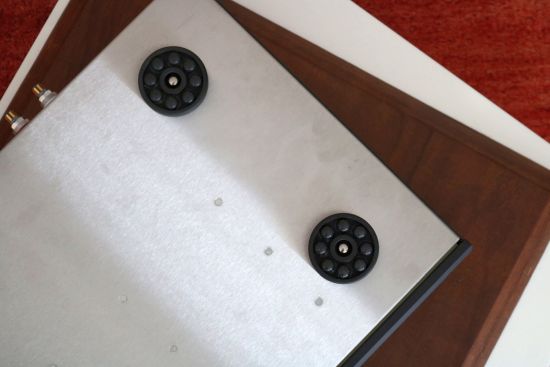
In addition to being a DAC, the DAC502 is also a RoonReady and UPnP endpoint. And it can be operated right from the listening position via a web interface on any device that has ethernet access. The web interface can be accessed by simply typing in the DAC’s IP address into any browser. The interface is clean and easy to use and offers not only access to all of the DAC’s functions but also UPnP and Roon transport controls and even shows album covers. Besides this, a nice IR remote control is also included.
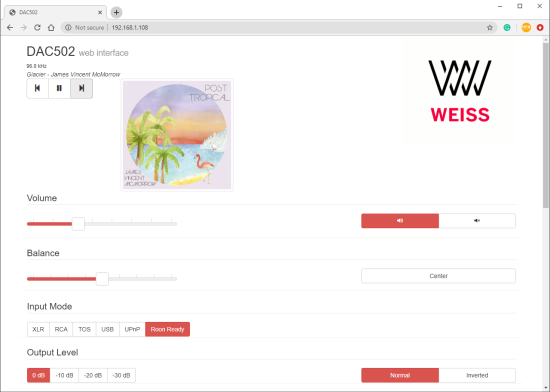
There are a total of five inputs: AES/EBU, Toslink, Coax, UPnP/DLNA, USB and Roon Ready. Accepted formats include PCM 44.1kHz up to 384 kHz and DSD 64x / 128x. The DAC has XLR and cinch outputs. The conversion is done via “two of the latest 32 bit D/A Converter chips”, interestingly, at a fixed 195kHz frequency which means that all the input signals are resampled to this frequency. According to Weiss, this helps significantly in reducing any jitter related effects. Included is an excellent digital volume control which I used throughout this review.
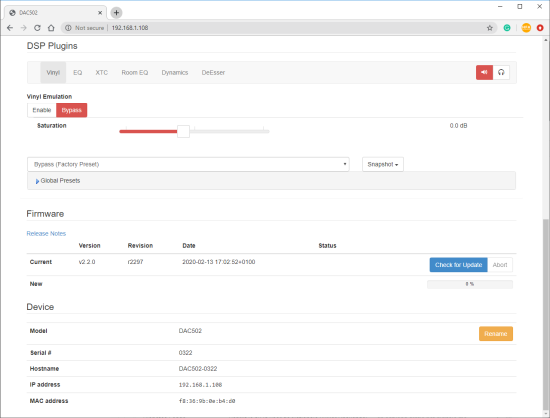
The front panel holds a small LCD touch screen that allows setting all functions while the rotary knob allows scrolling through the various menus. What I value very highly is the possibility to directly select the desired input rather than having to step through all the available ones. Also great is that all the relevant information is always shown simultaneously.
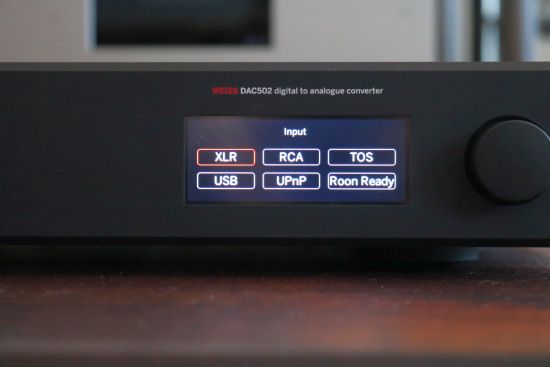
The 5xx range comprises two DAC models of which the DAC502 that is reviewed here uses a larger frame. This unit offers the same features as the DAC501 and adds a 4-pin headphone socket at the back of the unit. The smaller DAC501 is exactly the same product inside a smaller chassis and minus the 4-pin headphone socket on the rear (retaining the regular 6.3mm headphone socket on the front panel). Both DACs run from a sophisticated linear power supply.
Incidentally, the DSP501 / DSP502 units are the same as the DAC501 / DAC502 but with digital instead of analog outputs. This is ideal for customers who like to keep their trusted DAC or who have speakers with digital inputs.
Headphone connection
All types of headphones are supported thanks to the possibility of setting the basic output level in 4 steps. The DAC’s regular outputs and headphone outputs can be addressed individually. Thus, when selecting the headphone output, the signal processing chain is switched to headphone mode with independent headphone-related signal processing.
As it stands so far, the list of features already looks pretty impressive, doesn’t it? Now consider that I’ve not even covered its most powerful feature just yet, the DSP algorithms!
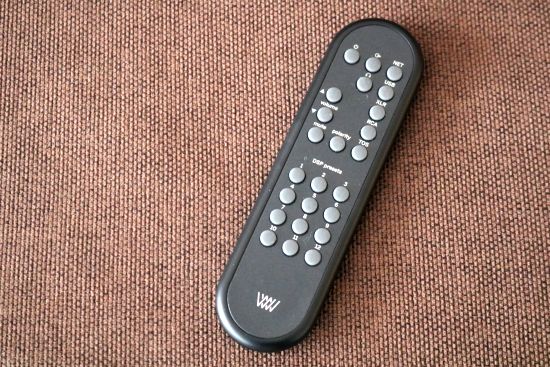
DSP functionality
The DAC502 includes a built-in selection of DSP algorithms offering an unprecedented range of control over virtually every aspect of the sound. Currently, there are 6 sections with countless parameters that can be tweaked and combined with one another. All of these settings are accessible via the web browser, right from the listening position. Additionally, there are 12 preset buttons on the IR remote control that allow direct selection of user-assigned snapshots. I will explain more about the DSP section further below, after the Listening section.
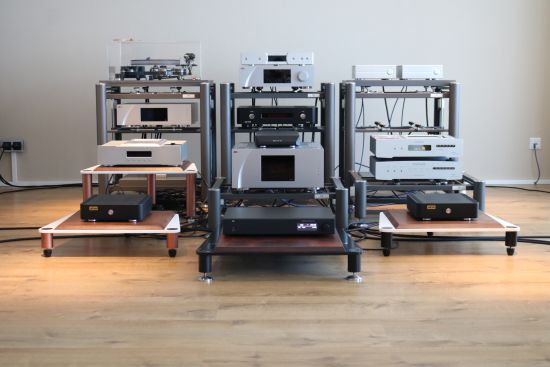
Review Context
The DAC502 will be reviewed in a system comprised of an Antipodes CX+EX music server combo, a CH Precision C1 DAC, a CH Precision A1.5 power amplifier with Martin Logan ESL15A and Magico S1 MkII loudspeakers. Additionally, I will make comparisons using the NuPrime ST-10 power amplifier and the APL DSD-AR DAC. For interlinks, I used CH Precision Balanced Link XLRs and Siltech Paris cinch. For power cables, I always use Belden 19364 with Bals schuko and Oyaide C-004 IEC connectors.
The DAC was brand-spanking new and thus I left it to play with the Antipodes server via USB with Roon on Radio Mode (Shuffle) for several days prior to any serious listening.
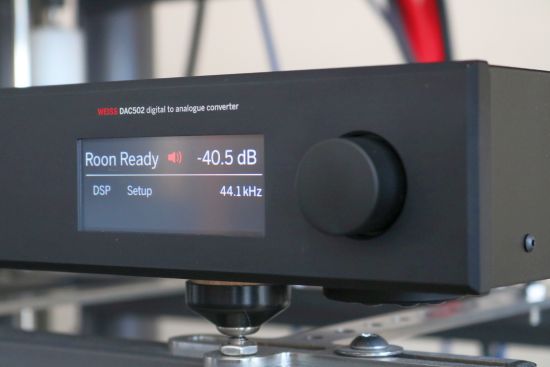
Listening – RoonReady
In use, the DAC502 is an absolute reviewer’s dream. It contains every function that one could ever want, poured into a very responsive UI with direct access to every function, topped off with utter stability. No matter how much I toggled its many functions or how many cables I plugged in or swapped, and that includes USB cables and network cables, the DAC502 would never lose its train of thought. The only thing worth noting is that for it to obtain a valid IP address, the Ethernet cable must be connected prior to switching on the unit.
Starting with the Magicos with the CH Precision A1.5 amplifier and the Weiss DAC502 fed directly via Ethernet from the Antipodes CX using its RoonReady input, the Weiss is soundwise as dependable as it is stable in operation. This is a dead-neutral, highly-revealing DAC with perfect timbre and a punchy, crispy and no-nonsense delivery.
Some may find it to sound a little “matter of fact” and although I would not disagree, leaving it there would be massively underselling it. Sure, it does not hide its studio heritage and it is definitely an analytical DAC. Relative to the average DAC sound (inasmuch as that even exists) I’d say that the DAC502 is slightly on the cool side but that does not mean that it inhibits any warmth that is in the recordings and I would not label it as clinical or sterile. I might if it were to sound overly lean or devoid of richness or color but that is not the case. The DAC502 has a fast and articulate delivery that extends all the way down into the bass which is remarkably crispy and well-controlled but also solid and authoritative. Along with this comes a pure and clean midrange that does not add any color or richness but simply relays all the richness and textures that are in the recording. While the DAC502 does not romanticize things, there is absolutely nothing etched, edgy or even the slightest bit hard about it.
Soundstage-wise, the DAC502 performs entirely in-line with its overall presentation: highly precisely. It does spread a little less widely and deeply than some other DACs such as the APL and the CH C1 but it images extremely sharply with crystal-clear focus. The overall presentation is neither laidback nor really forward but if I’m being picky, maybe it can seem a tiny bit forward compared to smoother sounding alternatives. This is probably a psycho-acoustic effect caused by the utter absence of blur. No doubt helped by its solid foundation, there is a good sense of depth to individual images within the soundstage.
Output Level
The DAC’s analog output level can be set in several steps and was at the -10dB setting for all the listening that I had done so far. Selecting the 0dB setting (and adjusting the digital volume accordingly) made for an even more crispy and solid bass but, as it follows, this came along with a drier treble.
Do note that this perceived dryness is nothing other than very high accuracy. Although I enjoyed the heck out of this super-expressive bass, the treble was now sometimes a little bit too revealing. Even if it adds a gentle rounding in the bass, it makes the overall sound more fluid, and so, for many systems without an analog preamp and with speakers as accurate as the Magicos, the -10dB setting will probably be ideal.
One can also tweak the sound in the other direction by selecting a higher level of attenuation. Higher attenuation settings add further smoothing which, while pleasing, with every step takes away a little precision and articulation. Ultimately, of course, the choice is up to the user and the setting is super-easy to make, right from the Web Interface.
